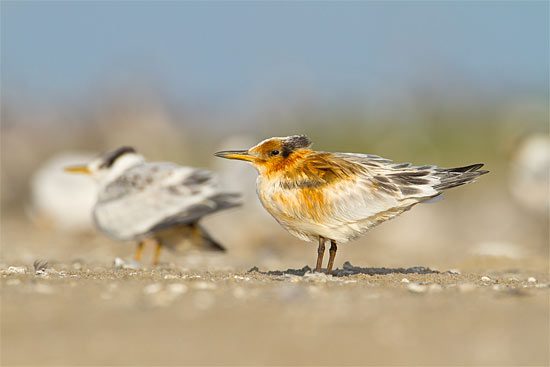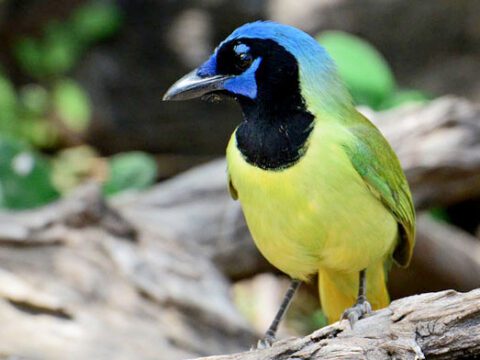Louisiana update: When oil stops, the hard work can begin (slideshow)
Text by Hugh Powell. Images by Gerrit Vyn and Benjamin Clock
July 29, 2010
Oil struck this island in early July 
Adult Royal Terns and their chicks gather at the water's edge 
Oil has coated these two Black Skimmer chicks up to their bellies 
Adults had the option to fly away from the oil, but the chicks couldn't leave the beach 
Small amounts of oil can weaken birds. The young tern at left is drooping one wing 
Oiled feathers ruin a bird's waterproofing and hinder its ability to stay cool under the blazing sun 
A very young Royal Tern chick with an oiled belly on Raccoon Island, Louisiana 
Oil contains toxins that can interfere with chick development 
Raccoon Island is one of the Gulf Coast's largest seabird nesting colonies 
Soiled feathers become waterlogged and useless when the bird enters the water 
This oiled immature pelican shows matted, disorderly breast and belly feathers 
Young Brown Pelicans gathered at the water edge or swimming are also vulnerable 
In closeup, the matted breast feathers and a line of oiling across the back are obvious 
Our team saw many lightly oiled tern chicks 
Thousands of Brown Pelicans breed here 
Pale young pelican chicks, still unable to fly, wander around the island
Our multimedia production team returned from their 7-week trip to the Gulf Coast on July 20. Coincidentally, that was just a few days after BP’s latest cap managed to stop the leaking oil (a permanent end is expected in August, when relief wells are completed).
It’s been a relief to finally glimpse the end of the oil gusher, and the New York Times reported Tuesday that oil on the surface of the Gulf appears to be dissipating rapidly. Scientists are less sure about the fate of underwater plumes of oil or the damage already done to fish and shellfish eggs and larvae. But the breakup of slicks represents some cautious good news for the pelicans, gulls, terns, and other birds—including migrating shorebirds and waterfowl—at risk of becoming coated with oil.
While the immediate danger may soon subside, the work to trace chronic impacts to bird populations is only beginning. In the long run, those impacts can take more of a toll than the headline-grabbing oil slicks—that was one of the key lessons from the Exxon Valdez spill (20-year report here). Scientists estimated that the number of birds harmed by long-term effects actually exceeded short-term deaths, which were estimated at about 250,000 seabirds.
Our team got to witness some less-obvious but still serious effects of oil at one of the last places they visited. At Raccoon Island, Louisiana, they saw pelican, Royal and Sandwich tern, and Black Skimmer chicks alive and moving around, but splotched or partially coated with oil. The birds weren’t debilitated, but closer observation, along with what we know from past research, still give cause for concern.
Many of the birds preened at their matted feathers, and with good reason. Oil clogs the feathers’ fine structure, depriving them of both their waterproofing and their ability to insulate. On shadeless beaches in 100-degree heat, those physical effects are dangerous enough, and they are compounded by chemical effects of the oil. Volatile compounds in oil irritate respiratory and digestive tracts, and other compounds interfere with hormonal cycles and development, an especially damaging problem for young birds.
Benjamin Clock, one of our photographers and a seasoned field biologist as well, described what he had seen. “The oil on the beach had weathered and a whole bunch of it was buried by the tide—but that was the least dramatic part,” he said. “The most dramatic part was seeing Sandwich and Royal terns of all ages, everything from fledged chicks to downy chicks, some heavily oiled on their crests and their wings, others with dollops on their wings or a single dollop on the belly.” He told me he had seen moderately oiled tern chicks standing in the sun and drooping one or both wings (there’s a picture of one in the above slideshow), as if weakened and unwilling to spend the strength to fold their wings completely.
Attempting to aid these lightly oiled birds is difficult and can endanger them. As biologist Michael Seymour, of the Louisiana Department of Widlife and Fisheries, explained to me after our visit to an oiled mangrove island, agency biologists pay close attention to oiled colonies, weighing that danger against the risks of disturbing a colony to conduct a rescue. Many lightly oiled birds can still fly, and even flightless chicks are agile runners. If rescuers were to chase down these birds, many other birds might leave their nests, be driven into the water, or otherwise come to harm through stress or exposure to predators. The biologists at the U.S. Fish and Wildlife Service and Lousiana Department of Wildlife and Fisheries have the unenviable task of making these decisions, and we fully support the work they’re doing.
Our team did not visit the entire island and they did not attempt a systematic survey of the number of oiled birds on the island. They visited only the eastern and western ends, where they saw what they judged to be a considerable number of oiled birds, most of them chicks. Clock said he thought oil must have arrived during a high tide that coincided with storm waves. Adult birds would have been able to take flight to get away, but the chicks couldn’t move away from the high water. Some of the photos in the slideshow above depict Black Skimmer chicks coated up to their bellies, as if they had waded through oily water.
Yet even this oiling, small as it is in comparison to the now-famous early photos of oil-smothered pelicans, is a larger and more obvious effect than the ecological repercussions scientists must look for in the coming years. After the last rescued bird has been cleaned and the last seabird chick of the year has taken wing, we can assess the damage done to individuals, and we can begin to investigate the damage done to populations.
Birds exist near the top of their food webs. As with our own species’ recovery from the spill, effects won’t become entirely apparent until the oil has done its damage to plankton, seaweed, marsh grasses, fish eggs, shellfish beds, marine larvae, and so on. We’re thankful that the immediate problem seems at least to have stopped getting worse. But for ecologists, our work is only beginning.

All About Birds
is a free resource
Available for everyone,
funded by donors like you
American Kestrel by Blair Dudeck / Macaulay Library




















